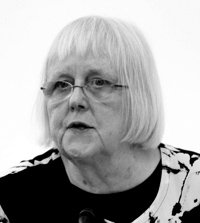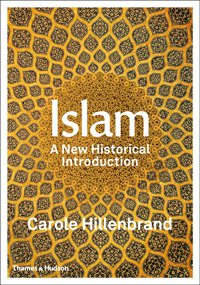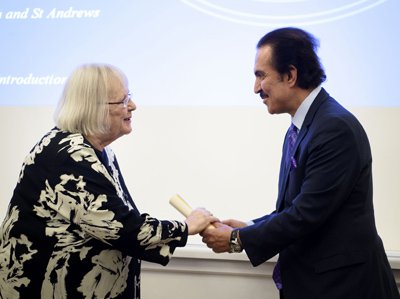
The print version of this article can be downloaded as a PDF file.
Carole Hillenbrand is Professor of Islamic History at the University of St Andrews, and Professor Emerita of Islamic History at the University of Edinburgh. She was elected a Fellow of the British Academy in 2007.
I am most grateful to Dr Nayef Al-Rodhan for his vision, philanthropy and great generosity in setting up this prize and thereby encouraging dialogue, tolerance and understanding between cultures and faiths. This is something that the world sorely needs. I am enormously happy and honoured to receive this prize.
In the recent context of 9/11, the wars in Afghanistan and Iraq, the collapse of Syria and the flood of migrants from Muslim lands making their painful way to a haven somewhere in Europe, it has never been more important for people in the West to learn about, and to understand, the Muslim world. This is a time when that world is rarely absent from our newspapers and TV screens, a time of wars and rumours of wars, and when public attitudes to Muslims at large are fraught with hostility and misunderstanding. So there is the most urgent need to combat the massed forces of prejudice and ignorance.

This is in one sense a textbook; my publishers, the incomparable Thames and Hudson, fervently hope that it will be widely adopted as a core text in hundreds of freshman courses in the USA and Canada on religion, on Islam and on Asian and of course Islamic history. In fact this is already happening. Th at is, so to speak, the school and college dimension. But I also wrote it with another constituency in mind, and here too I had the full support of Thames and Hudson. That is the wider public, a public that has had its fill of shrill, tendentious rants from the media on the subject of Islam as a faith and a culture, and is hungry for a more accurate and balanced account.
And I hope that I can claim still more for this book. It is close to my heart – for despite occasional evidence to the contrary, academics have hearts as well as minds. I am gradually coming to the end of my career, and into this book I have poured the fruit of almost half a century of reading and thinking and teaching about Islam, not only as a religion but also as a culture of world standing. This book is a meditation on all of that, and on my lifelong specialised work as an Islamic historian, and as a teacher of Arabic and Persian. The book also reflects a personal lived experience of many very diff erent Muslim societies. For underpinning my academic work is something quite other, but equally valuable, namely the vivid memories of travels which have taken me the length and breadth of the Muslim world, from Senegal to South-east Asia, interspersed with lengthy stays in Syria, Jerusalem and Iran. Those travels began exactly 50 years ago and they continue apace. They put real people on the page as well as ideas. And if the book refl ects the profound respect and admiration that I have for the Muslim world, its culture and its people, I shall be well pleased.
This book, then, is an attempt to give readers a bird’s-eye view of the beliefs and practices of Islam from a historical perspective. That is something to emphasise – for essentially this is a book about a faith. It is framed by an introduction and a closing chapter entitled ‘Tomorrow’. That, incidentally, is a chapter that is already scheduled for revision in a second edition, and indeed I have already re-visited it for the Italian edition that was published earlier in 2016. The list of contents focuses on nine core topics – Muhammad, the Qur’an, Faith, Law, Diversity, Thought, Sufism, Jihad, and Women. Each of these has between fi ve and nine sub-sections, also listed under each major chapter heading. Th is is intended to make it as easy as possible to track down the discussion of a given topic.
Authors customarily thank their publishers. And so they should. But in my case this is anything but a formality. I count myself very fortunate to have had a stellar team from Thames and Hudson who have watched over every stage of the book, from its conception to the day of publication.
And I would like to express again my enormous gratitude to Dr Nayef Al-Rodhan. By founding this prize he has made an ongoing and far-sighted contribution to the cause of harmony and peace between the multiple faiths and cultures that make up our complex and globalised world.

Professor Carole Hillenbrand FBA received the Nayef Al-Rodhan Prize for Transcultural Understanding from Dr Nayef Al-Rodhan, at a ceremony held at the British Academy on 31 October 2016. This is the most valuable of the British Academy’s prizes, worth £25,000. It was founded by Dr Al-Rodhan in 2013 to honour outstanding work that illustrates the interconnected nature of cultures and civilisations.
Professor Dame Helen Wallace FBA, who chaired the prize jury, said:
The focus of this prize on ‘transcultural understanding’ is in some ways too appropriate for the challenging times in which we live. We have identified a fine prize winner. Let me read out the citation:
‘The jury recommends the award of the prize to Professor Carole Hillenbrand for her volume Islam: A New Historical Introduction, and for the body of her scholarship on which it draws. The volume summarises in an unusually accessible and finely presented form important insights into Islam in its variety of contexts and regions in ways that speak to many of our current challenges in understanding the Islamic world and its beliefs. The jury applauds Professor Hillenbrand’s endeavours in translating scholarly analysis and deep historical knowledge into a volume designed to promote public understanding. These reflect her active engagement throughout her professional life in promoting the study of the Islamic world in the wider academic community as well as in organisations such as CARA (the Council for At-Risk Academics).’
Professor Hillenbrand has a fine record of scholarly achievement and of professional engagement. Her historical work delves deeply into Islamic history across a range of countries, her scholarship hugely strengthened by her remarkable command of languages. This underpins Professor Hillenbrand’s empathetic understanding of many diff erent cultures and traditions.
However, the award of this prize needs more than fine scholarship: it requires that it is communicated to wider audiences. Professor Hillenbrand writes in her preface to this volume that her aim was to reach general readers ‘interested in understanding complex current events happening in the name of Islam’. This is indeed a subject which calls for thoughtful and nuanced analysis. I commend the volume to you all wholeheartedly – and not least because it is a beautifully produced volume with outstanding illustrations.